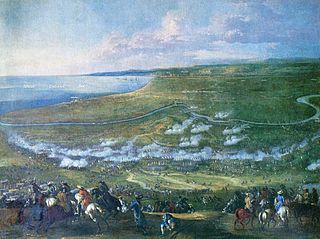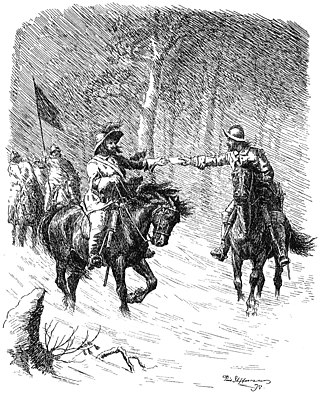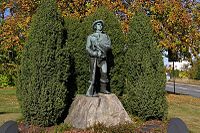
Charles XI or Carl was King of Sweden from 1660 until his death, in a period of Swedish history known as the Swedish Empire (1611–1721).

Skåneland or Skånelandene (Danish) is a region on the southern Scandinavian peninsula. It includes the Swedish provinces of Blekinge, Halland, and Scania. The Danish island of Bornholm is traditionally also included. Skåneland has no official recognition or function and the term is not in common usage. Equivalent terms in English and Latin are "the Scanian Provinces" and "Terrae Scaniae" respectively. The term is mostly used in historical contexts and not in daily speech. In Danish, Skånelandene is used more often. The terms have no political implications as the region is not a political entity but a cultural region, without officially established administrative borders.

The Treaty of Roskilde was negotiated at Høje Taastrup Church and signed (NS) during the Second Northern War between Frederick III of Denmark–Norway and Karl X Gustav of Sweden in the Danish city of Roskilde. After a devastating defeat, Denmark–Norway was forced to give up a third of its territory to save the rest, the ceded lands comprising Blekinge, Bornholm, Bohuslän (Båhuslen), Scania (Skåne) and Trøndelag, as well as her claims to Halland.
The history of the province of Scania was for many hundred years, up until the 18th century, marked by the struggle between the two Scandinavian kingdoms of Denmark and Sweden over the hegemony in the Baltic area.

Scanian is a dialect of Swedish spoken in the province of Scania in southern Sweden.

The Øresund Region, also known as Greater Copenhagen for marketing purposes, is a metropolitan region encompassing the Capital Region of Denmark and Zealand, in eastern Denmark, and Scania, in southern Sweden. Centred around the Øresund strait and the two cities which lie on either side, Copenhagen in Denmark and Malmö in Sweden, the region is connected by the Øresund Bridge, which spans the strait at its southern end, and the HH Ferry route between Helsingør, Denmark, and Helsingborg, Sweden, at the narrowest point of the strait.

The Battle of Lund, part of the Scanian War, was fought on December 4, 1676, in an area north of the city of Lund in Scania in southern Sweden, between the invading Danish army and the army of Charles XI of Sweden. The Danish had an army of about 13,000 under the personal command of 31-year-old King Christian V of Denmark, aided by General Carl von Arensdorff. The Swedish army, which numbered about 8,000, was commanded by Field Marshal Simon Grundel-Helmfelt and the 21-year-old Swedish king Charles XI. It is one of the bloodiest battles in percent of casualties on both sides ever fought in Scandinavia.

The Count's Feud, also called the Count's War, was a war of succession that raged in Denmark in 1534–36 and brought about the Reformation in Denmark. In the international context, it was part of the European wars of religion. The Count's Feud takes its name from the Protestant Count Christopher of Oldenburg, who supported the Catholic King Christian II, deposed in 1523, over the election of Christian III, a staunch Protestant who had already implemented Lutheranism as the state religion in Schleswig and Holstein in 1528.

The Scanian War was a part of the Northern Wars involving the union of Denmark–Norway, Brandenburg and Sweden. It was fought from 1675 to 1679 mainly on Scanian soil, in the former Danish–Norwegian provinces along the border with Sweden, and in Northern Germany. While the latter battles are regarded as a theater of the Scanian war in English, Danish, Norwegian and Swedish historiography, they are seen as a separate war in German historiography, called the Swedish-Brandenburgian War.

The Battle of Halmstad, also known as the Battle at Fyllebro, was fought on August 17, 1676, at Fyllebro, approximately 4 km (2.5 mi) southeast of the town of Halmstad in the province of Halland in southwest Sweden. It was the last battle in Halland between Denmark and Sweden.

Snapphanar is a Swedish miniseries directed by Måns Mårlind and Björn Stein that aired in three parts on Sveriges Television during Christmas 2006. It is a historical drama about the Snapphane peasant rebel movement that fought against the Swedish rule of Scania in the 17th century. The "Snapphanar" fought secretly for Denmark during 1660–1700.

The March Across the Belts was a military campaign waged by the Swedish Empire across the ice between the Danish islands. It lasted between 30 January and 15 February 1658, ending with a decisive victory for Swedish King Charles X Gustav during his first Danish war.

The Battle of Helsingborg was the last major engagement of the Great Northern War to take place on Swedish soil, and resulted in a decisive victory of a Swedish force of 14,000 men under the command of Magnus Stenbock against a Danish force of equal strength under the command of Jørgen Rantzau, ensuring that Denmark's final effort to regain the Scanian territories that it had lost to Sweden in 1658 failed. The battle was fought on March 10, 1710, in the province of Scania, just outside the city of Helsingborg, and directly on the Ringstorp heights just north-east of the city.

The Dano-Swedish War of 1658–1660 was a war between Denmark–Norway and Sweden, with the former backed by the Dutch Republic and Poland. It is known in Denmark as the Second Karl Gustav War, in Norway as Bjelkes Feud in Sweden as Karl Gustav's Second Danish War, and in the Netherlands as the Swedish-Dutch War.

Scania, also known by its native name of Skåne, is the southernmost of the historical provinces of Sweden. Located in the south tip of the geographical region of Götaland, the province is roughly conterminous with Skåne County, created in 1997. Like the other former provinces of Sweden, Scania still features in colloquial speech and in cultural references, and can therefore not be regarded as an archaic concept. Within Scania there are 33 municipalities that are autonomous within the Skåne Regional Council. Scania's largest city, Malmö, is the third-largest city in Sweden, as well as the fifth-largest in Scandinavia.

Svend Poulsen, also referred to as Svend Poulsen Gønge was a Danish military commander in the 17th century, serving in the armies of Christian IV, Frederick III, and Christian V. He fought in the Torstenson War, Second Northern War, and the Scanian War, and led the snaphane militia in guerilla warfare against Sweden in occupied Zealand from 1658 to 1659. He was popularized under the name Gøngehøvdingen in 1853, when his exploits were fictionalized under that name by Danish author Carit Etlar. The historicity of his aliases has since been disputed.
Per Uno Agathon Röndahl was a Swedish police officer and author. Uno Röndahl’s writings centered on Scanian history and especially the war events taking place in the province of Skåne and in particular in the border areas between contemporary Danish Skåne/Blekinge and Swedish Småland during the period 1645-1720.
Swedification refers to the spread and/or imposition of the Swedish language, people and culture or policies which introduced these changes. In the context of Swedish expansion within Scandinavia, Swedification can refer to both the integration of Scania, Jemtland and Bohuslen in the 1600s and governmental policies regarding Sámi and Finns in northern Sweden during the 1800s and 1900s.
Baron Jörgen Iversen Krabbe of Krogholm Castle (1633–1678) was a Danish jurist and later a Swedish nobleman, who was one of the most influential men in the province of Scania and played an important role during the Scanian War of 1676–1679. He was executed by the Swedes for high treason.
Jens Mikkelsen Ehrenborg was a Danish soldier and public servant who later became a Swedish nobleman. He was born in 1621 in Fredericia in southern Jutland in Denmark. His name was also spelled Jöns Michelsson, Jens Michelsen or Jöns Michaelson. Upon his ennoblement in 1687, he was given the surname Ehrenborg.

![Snapphanen
from 1934 by artist Axel Ebbe [sv] portraits the snaphane
Lille Mads, a member of the pro-Danish guerrilla active in southern Sweden in the 17th century. The statue is placed in the Hembygdsparken
park in Hassleholm (older Danish: Hasselholm) Snapphanen av Axel Ebbe-1.jpg](http://upload.wikimedia.org/wikipedia/commons/thumb/1/1c/Snapphanen_av_Axel_Ebbe-1.jpg/220px-Snapphanen_av_Axel_Ebbe-1.jpg)













